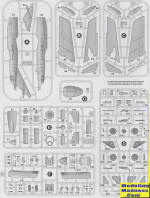
| KIT #: | 72038 |
| PRICE: | HK$25 |
| DECALS: | One option |
| REVIEWER: | Scott Van Aken |
| NOTES: |
New tool kit |

| HISTORY |
In January 1948, the Soviet Union issued a specification for a long-range, all-weather Interceptor, capable of intercepting hostile aircraft far from the attacker's targets by day and night. The specification resulted in designs from several design bureaus, including Mikoyan-Gurevich, who proposed the Izdeliya R ("Article R") or I-320, Lavochkin (the La-200) and Sukhoi (the Su-15).
The Mikoyan-Gurevich design, was like the other two competing aircraft, a twin-engined swept-wing aircraft, with the fuselage housing the engines in tandem, with one at the bottom of the forward fuselage and the second in the rear fuselage. The engines were fed from an inlet in the nose, which split into three ducts, the first feeding the forward engine and the other two passing around the cockpit to feed the rear engine. The crew of two (aircraft commander and radar operator, who were provided with dual controls) sat on individual ejector seats in a side-by-side, unpressurised cockpit. The wings, which were of similar layout to those of the smaller MiG-15 day fighter, were swept at an angle of 35 degrees, and were fitted with large wing fences. Air intercept radar, at first Toryii and later the much improved Korshun, was fitted in a radome in the upper lip of the air intake.
The first prototype, designated R-1, was powered by two 22.25 kN (5,000 lbf) thrust Klimov RD-45Fs, unlicensed copies of the British Rolls-Royce Nene engine, and was armed with two Nudelman N-37 cannon, positioned on either side of the air intake. It made its maiden flight on 16 April 1949. A second prototype, R-2, which differed in having more powerful (26.25 kN (5,900 lbf)) Klimov VK-1 engines, a third N-37 cannon and an improved windscreen and canopy followed in November 1949. The R-2 was badly damaged when a cannon shell exploded, and the aircraft was rebuilt, with the wings modified, adding a third fence, flying again as the R-03 on 30 March 1950.
No production followed, as the specification to which the I-320 was built was superseded by a later requirement that led to the production of the Yakovlev Yak-25. The two prototypes continued in use by the MiG design bureau as testbeds for the development of avionics.
| THE KIT |
 In
the few years that Modelsvit has been in existence, the quality of their kits
has been improving. They are still considered short run but are devoid of the
flash, ejector towers and other molding issues. The sprue gates still slightly
encroach on the parts, but not to the extent of some. Surface detailing is very
good with the engraved panel lines being nice as crisp.
In
the few years that Modelsvit has been in existence, the quality of their kits
has been improving. They are still considered short run but are devoid of the
flash, ejector towers and other molding issues. The sprue gates still slightly
encroach on the parts, but not to the extent of some. Surface detailing is very
good with the engraved panel lines being nice as crisp.
This is a twin engine fighter and so there are quite a few parts. Some of these are for the forward engine, which one builds in its entirety. This is because it can be seen down the intake ducting. Not an issue for the rear one, so only the last compressor stage and tailpipe are included for that.
There are two five-piece seats for the crew and this fits onto the floor of the cockpit. There is sidewall detailing provided. A decal is included for the main instrument panel. Nose gear well is built up between the sections of the inner intake walls. Building up the intake/cockpit section looks complex, so test fit a lot before gluing. With all the interior/engine/intake/exhaust pieces done, these can be installed into the fuselage and the halves closed. The forward intake and radome and then attached. 5 grams of weight is recommended to fit into the radome.
One then assembled the wing tanks and builds the
wings. Holes need to be opened for the tanks if you wish to use them. Each main
gear well is five pieces. These and the tailplanes are then attached to the
fuselage. Then the nose and main landing gear legs, wheels, struts and doors are
attached. Note that there is one more wing fence to attach as this is the third
prototype. If you leave off the outer fence, you
 can do the
second prototype. The canopy is one part and quite clear. Speed brakes can be
posed open or closed.
can do the
second prototype. The canopy is one part and quite clear. Speed brakes can be
posed open or closed.
Instructions are well done with Humbrol and generic paint references. The aircraft is overall unpainted metal with mid-green tail tip and medium grey nose ring and radome. Engine exhaust areas are gun metal. The small decal sheet is nicely printed. The kit also provided a set of canopy masks.
| CONCLUSIONS |
| REFERENCES |
August 2022
Copyright ModelingMadness.com. All rights reserved. No reproduction in part or in whole without express permission from the editor.
If you would like your product reviewed fairly and fairly quickly, please contact the editor or see other details in the Note to Contributors.